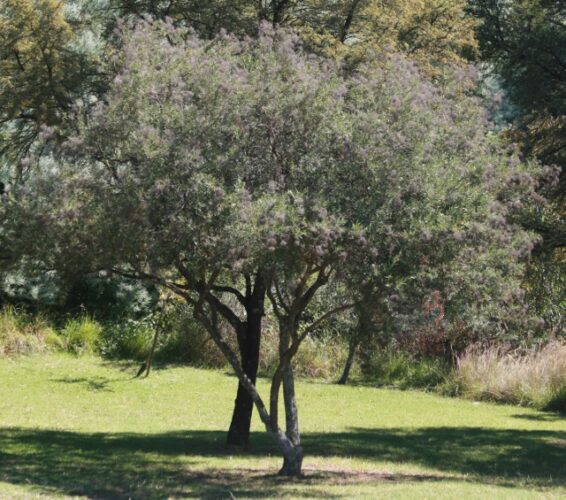As we come to the end of Arbor Week, we are looking at reasons to plant trees.
Many plot dwellers are conscious of their duty to adapt their lifestyles in order to lessen their impact on the ecosystem. One of the things that we are often encouraged to do is to plant trees, as a way of offsetting carbon emissions.
However, some South African researchers in the fields of biological sciences and climate change seriously doubt the wisdom or efficacy of planting large numbers of trees, particularly in grasslands such as we have in Gauteng.
We should not try to create mini-forests on our smallholdings, even if we were to use trees that naturally occur on the Highveld.
We would rather suggest that smallholders plant trees on their plots for other reasons.
Plant Windbreaks
A windbreak is of course a barrier placed in the path of the wind to divert its flow upwards. Trees make the most effective windbreak because they grow tall, they are long lasting and the space between them can be adapted. The wind speed is considerably lessened with the result that the physical damage to flowers, fruit and plants, caused by hail, snow and sand, is decreased or even prevented. The quality and size of crops are therefore improved.

A lower wind speed offers greater protection to animals. Animals are less exposed to heat and cold, and losses as a result of deaths and decreased production are lower. The sheltering effect of trees reduces convectional heat loss from livestock in winter.
If you plant a double row of trees as a windbreak, you can use one of the rows in time for saw-timber, poles or firewood.
Where winters are exceptionally cold and windy, plant your windbreaks in the shape of a square, right angle or circle. The ideal shape, however, is that of a kidney.
Under certain conditions there are some tree species that offer greater advantages than others. In the cold areas where frost occurs, deciduous trees are more advantageous than evergreens. Because deciduous trees lose their leaves in winter, they allow greater air movement through the branches. This results in is less frost. Evergreen trees can be planted together with more widely spaced deciduous trees within the windbreak.
Start your windbreak with fast-growing trees and shrubs inter-planted with slower-growing trees.
Which trees to plant as windbreaks
To obtain maximum effectiveness, a thick hedge can be planted on the side opposite to the prevailing cold wind. Consider planting Buddleja Auriculata (Weeping Sage) or Buddleja Glomerata (Karoo sagewood), while Dovyalis Caffra (Kei-apple) makes an impenetrable hedge. Small to medium trees (2 – 8 m) include Acacia Karroo (Sweet Thorn), Acacia Hebeclada (Candle thorn), Brachylaena Discolour (Wild Silver Oak), Brachylaena Discolour var Transvalensis (Coast silver oak) and Dodonaea Viscosa (Sand Olive). Taller indigenous trees include Celtis Africana (White Stinkwood) (8 – 10m) and Podocarpus Falcatus (Outeniqua yellowwood) which in Gauteng can reach a height of 12m.
Plant trees for shade
Trees also provide valuable shade for livestock, to counteract the detrimental influence of heat as well as of cold on the production of milk and meat, to ensure the survival of newly born animals, and to prevent the weathering of wool.

Plan your stock-watering points together with the planting of trees. At every watering place and in every grazing camp, a minimum of two trees must be planted to prevent overcrowding of animals under a single tree. Too much manure and urine, together with soil compaction, will cause a single tree to die.
Shade trees reduce radiant heat off the ground during summer. Therefore, shelter from pasture trees decreases stress in livestock by providing more comfortable living conditions. We often see horses and cattle resting adjacent to a tree line to shelter them from the sun or wind.
Good shade trees of different sizes include Ekebergia Capensis (Cape Ash), Euclea Crispa (Blue Guarri), Halleria Lucida (Tree Fuchsia), Peltophorum Africanum Sond. (African Wattle), Acacia Galpini (Monkey Thorn), Acacia Karroo (Sweet Thorn), Calodendrum Capense (Cape Chestnut) or Combretum Zeyheri (Large fruited Bushwillow).
If you are choosing a tree to plant in a pasture make quite sure that the fruit, flowers, seeds or bark are not poisonous to livestock. For example the pods of Albizia versicolor and Albizia tanganyicensis are highly toxic to stock, while the common name for Smodingium argutum is Agonybush or African Poison Ivy, which says it all.
Stabilising soil. Trees in the pasture have the added effect of stabilising the soil and reducing soil erosion. Leaf litter and small fallen twigs add organic matter which improves soil fertility.
Plant trees to create habitats
An added benefit is that many of these trees provide homes and food for birds and butterflies, as well as nectar for bees.
If trees need to be planted in veld where there is no regular supervision, animals can be kept at bay by covering the trees with thorny branches or barbed wire.
For young trees, fencing is necessary to exclude the animals from trampling the trees, crushing shallow tree roots and browsing on the trunks and branches. Fencing will prevent rubbing injury to trees from livestock that like to scratch.
For other articles on growing trees click here.

